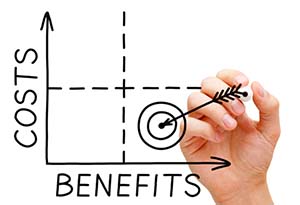Your business website might be a simple sales channel or the foundation of your marketing plan, especially if you use the site for direct sales, lead generation, or customer relationship maintenance.
 You might see the cost of the site as a business expense but I'd like to suggest you consider it an investment instead.
You might see the cost of the site as a business expense but I'd like to suggest you consider it an investment instead.
Businesses invest in a lot of things, such as equipment, office or manufacturing space, product development, employees and training, and raw materials.
The goal with all of them is to generate more revenue than the cost of the investments.
Your “return on investment” (ROI) is the answer to the question: “For every dollar I spent, how many dollars did I earn?”
For websites, like anything else, the ROI should be positive (and as large as possible).
A website ROI can be used to measure the site's design and functionality as well as the success of its marketing efforts.
Calculating a website's ROI can be tricky, especially if you don't run a pure eCommerce site.
And there are factors that are beneficial but hard to quantify, like the value of maintaining customer relationships via the site, the site's impact on brand awareness, and its ability to attract new leads.
There are a few terms we should define at this point…
 The traffic your site gets is viewable in Google Analytics (assuming your web team set it up). Google Analytics can also be configured to show the number of conversions.
The traffic your site gets is viewable in Google Analytics (assuming your web team set it up). Google Analytics can also be configured to show the number of conversions.
The average conversion rate, over a wide variety of sites, is 2-5% of traffic. Increasing your conversion rate can be achieved via website optimization, which does not always require a full redesign.
The basic ROI calculation is “revenue from the site minus total site cost (build & maintain) divided by total site cost” (and shown as a percentage).
For example, if a site generated $100,000 in one year, and its total cost that year was $20,000, its ROI is (100,000 - 20,000) / 20,000 = 400%. In this example, every $1 invested in the site led to $4 in net revenue.
 So if you know your numbers (gross revenue and total cost) you can easily calculate your ROI.
So if you know your numbers (gross revenue and total cost) you can easily calculate your ROI.
The real ROI might actually be a bit larger than what you calculate because of things like “lifetime customer value” (LTV) which is the total amount of revenue you get from repeat customers over a long period of time.
It's hard to figure out LTV, but it's important to know that it's usually less expensive to maintain a current customer that generates additional revenue than to gain a new customer. A good website can help significantly with things like this.
There are small costs and large costs, including things like web domain registration, website hosting, design and development fees, maintenance and updating fees, and SEO and online marketing fees.
Some companies put SEO and online marketing in their overall marketing budget if they keep that separate from their website budget.
 As with many things, you often get what you pay for.
As with many things, you often get what you pay for.
It's possible to spend very little on a website, either by using a DIY builder like Wix or Squarespace or by hiring a less-experienced freelancer.
Some people who do this find that they end up with a lower-quality site that's less effective at getting their message across and generating revenue.
Spending more up front can seem risky, but when you invest smartly, you can get a much higher website ROI.
Make sure your website functionality works well and the info people are looking for is clear and easy to find.
Take the “soft sell” approach. Too many popups or aggressive pitches will turn off visitors.
Keep your site simple, clear, and well-written. To many distractions (or too much information) may cause visitors to leave and hurt your ROI.
Put a clear “call-to-action” (CTA) on every page. The goal is to guide the visitor to the action you want him to take on that page, even if it's just going to another page.
Use honest, and not artificial, search engine optimization (SEO) techniques. These will actually be less expensive and produce better results.
Whether you're building a new site or redesigning an existing one, make sure you understand the costs to keep it updated.
Sometimes it's less expensive to use a content management system (CMS) like WordPress and train staff how to use it, but sometimes it's actually cheaper to just pay someone else to do the work for you.
 A website is not something to pinch pennies on. Just like the difference between a good doctor and a great one can be huge, the same is true for websites.
A website is not something to pinch pennies on. Just like the difference between a good doctor and a great one can be huge, the same is true for websites.
A good website might cost, for example, $10,000 while a great one might cost $20,000. But if the great one generates an additional $100,000 in revenue over a few years, spending more up front will have been well worth it.
Any website that's not “just for fun” should be generating revenue and the goal should be to maximize its return on investment.
To boost ROI, you first have to measure it. Then you can take steps to improve your site to get more bang for the buck.
Are you getting a good ROI on your website? Need help measuring it?
Get in touch and let me know…